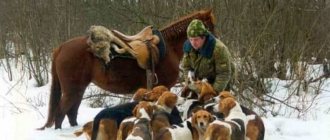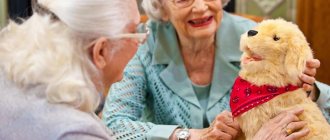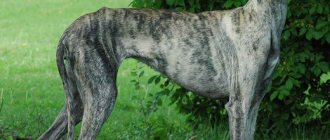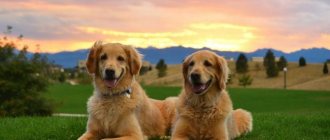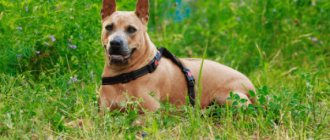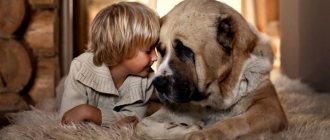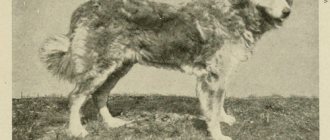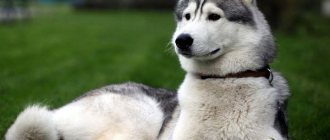Breed characteristics
| Short description | |
| Origin: | Netherlands |
| Conditions of detention: | House, apartment, local area (kennel) |
| Purpose: | Hunting dog, companion |
| Color: | White with large tan or reddish spots |
| Wool length: | Average |
| Adult dog size: | The height of the female is 38-40 cm, the male is 40-42 cm, weight is 9-11 kg |
| Average life expectancy: | 12-14 years old |
| Walk: | Twice active walking is required |
| Physical activity needs: | High physical activity needs (daily walks with vigorous exercise, participation in hunting or dog sports) |
| Fédération Cynologique Internationale (FIC) classification: | Group 8: Retrievers, Spaniels and Water Dogs; section 2: spaniels |
| Puppy price: | 30,000-60,000 rubles. Without pedigree - 30,000-35,000 rubles, pet class - up to 40,000 rubles, breed class - 45,000-50,000 rubles, show class - 60,000 rubles. |
Maintenance and care of the Kooikerhondje breed
The Koikerhondje breed belongs to group 8 - retrievers, bird dogs, "water" dogs. Section 2 – poultry dogs
Dogs of this breed are not suitable for keeping in an apartment or in the city. They require constant physical activity and therefore they feel best in rural areas, where they will have many opportunities and space for free movement, walking and, of course, hunting.
A hardy dog, not afraid of cold and damp weather.
The Kooikerhondje dog is easy to raise and maintain, but it needs a leader, without which it becomes insecure and disobedient.
Grooming
This dog is easy to care for and looks beautiful when well looked after. Dogs of this breed have water-repellent fur, dirt does not linger on it, and the dog just needs to shake it off to become clean and dry again.
It should be brushed regularly, twice a week, with a bristle brush, and the decorative hair and dewlap on the tail should be brushed with a comb.
Amenability
They are not too trusting of strangers and try not to approach them.
Gets along well with the owner and others. Kooikerhondje will be loyal to those to whom they are accustomed throughout their lives.
If children treat it unceremoniously, the dog will not tolerate it.
Diseases of the breed
Kooikerhondjes have an excellent appetite and tend to gain weight easily. They have a relatively small gene pool, so genetic diseases are common, including von Willebrand disease (a bleeding disorder); cataracts and other hereditary eye diseases; dislocation of the kneecap. They were found to have a defective gene.
Diet: Do not overfeed due to the tendency to obesity.
Life expectancy: 12-14 years.
Psychological picture
They are very dependent on their environment, affectionate, cheerful and active. In addition, they are smart, attentive and always ready to please their owner.
Kooikerhondjes quickly adapt to their surroundings and change their behavior from calm to active if the situation allows.
They respect their owner, they are ready to do anything for him, they need constant communication with their household. They are happy to work together with the owner, especially if he praises them.
History of the origin of the species
A real working dog: it will clean the house of rodents, bring game, and help the farm. According to official data, the breed appeared in the north of Holland at the end of the 16th century, but, according to historical references, these animals have been serving humans for more than 5 centuries.
One of the Spaniels was the favorite of William II of Orange. The dog woke up the monarch when he sensed the advance of the Spanish troops, which saved not only the prince, but the entire kingdom. After this incident, the breed became the official symbol of the Dutch kingdom. This is where the first name came from. “Koikerhondje” literally translates as “duck hunter”.
An interesting feature of the breed is its hunting style, tolling. Animals do not simply bring killed or shot game in their teeth, they lure it to the shore (into a built trap) by waving their tail. Only two species work this way - Nova Scotia Retrievers and Dutch Spaniels.
Due to the decline in the popularity of duck hunting, the number of animals has decreased. In 1942, work began to restore the species, and in 1966 the first standard was written. Spaniels have been officially recognized since 1971.
Care
Weekly grooming for this breed includes the following: nail trimming - strong and fast-growing, they require regular trimming with clippers, otherwise the nail plate may crack; examination of the ears - the ears should be checked quite often, as earwax and debris quickly accumulate in them, which can lead to infection; cleaning the oral cavity - the condition of the dog’s teeth must be monitored especially carefully, since the formation of tartar is easier to prevent than to cure.
The Kooikerhondje rarely needs bathing (with the exception of daily washing of its paws after a walk) - its coat becomes dirty slowly, but a timely shower will relieve the dog of itching and unpleasant odor. There is no need to specifically comb the dog after water treatments.
The Kooikerhondje sheds mainly during the seasonal coat change - in spring and autumn. Shedding is noticeable, but not excessive - it is enough to brush the dog for a few minutes several times a week.
Representatives of this breed are in good health. A modern breed club today does not allow dogs suffering from cataracts and luxating patellas to be bred. However, future owners should ask the breeder for a medical history of the puppy’s parents, and then they should take the dog to the veterinarian at least once a year.
Subscribe to our newsletter and get a free veterinary consultation
Thanks for subscribing!
Distinctive features
This breed is a Spaniel, in the classical sense: an elongated, dry body, a long muzzle, hanging large ears with feathering, strong limbs. The peculiarity of the species is its stable color (white with red spots and black “earrings”). Representatives are slightly smaller than their English counterparts (at the withers no more than 42 cm, weigh up to 11 kg).
- The head is dry and elongated. The forehead is wide with a soft groove, the skull is rounded with a smooth occipital protuberance.
- The muzzle is slightly shorter than the skull, tapering towards the nose, and the topline is straight. Strong jaws, but soft grip.
- The nose is black and large.
- The eyes are set at stop level, large, almond-shaped with a friendly, intelligent look and dense, wide eyelids.
- The ears are long, soft, thin, set low, hanging down and lying close to the cheekbones. Round in shape.
- The body is elegant, dry, with smooth outlines. The back is straight, the croup is slightly lowered and rounded. The belly is tucked in, the neck is gently curved, the withers are not pronounced. Chest of medium volume.
- The tail is long, not thick, surrounded by hair. In a calm state it hangs down, in an active state it rises to the level of the back (forms a straight line with the croup).
- The limbs are sinewy, thin, straight. The rear ones are slightly retracted. The movements are sweeping and dexterous.
- The coat is two-layered: a soft, thick, water-repellent undercoat and silky long guard hair.
- Color – white with red spots: symmetrical on the head (around the eyes, flowing onto the ears); on the back; on the side and neck. At the tips of the ears there is a gradient (from brown to black).
Description of the Kooikerhondje breed (standard requirements)
Having been revived, the breed of these dogs received the standards appropriate to it. Modern purebred Kooikerhondjes ( you can see this in the photo massive elongated muzzle with a white stripe; head with a tubercle on the back of the head; medium-sized, hanging ears; smooth lines of a round forehead.
Pictured is a Kooikerhondje dog.
Their eyelids, nose and tightly compressed lips are dark in color. Small eyes stand out with raised corners. The neck of a purebred representative of an ancient breed is muscular, but at the same time, highly raised, smooth and graceful; the body is oblong, the chest is oval, pushed forward, the croup is raised, the stomach is tucked; The oval front paws are larger than the hind paws, and the toes are webbed.
A description of pure-blooded Kooikerhondjes is impossible without mentioning that their two-color color, consisting of areas distinguished by red, as well as a white shade of fur on the chest, paws and belly, must necessarily be complemented by black feathers in the form of earrings on the ears, which stand out with long hair.
The weight of these animals is about 13 kg, and their thick fur has the ability to repel water. And the most important element, of course, is a wonderful tail with long feathers below.
Photo of an adult dog
Training
The Kooikerhondje breed is considered one of the smartest, therefore, an experienced owner should not have any difficulties training it.
It is very important that the animal is socialized in the right conditions. Household members should not treat him rudely or impolitely
This animal is extremely vulnerable. It will not give its offender a physical rebuff, but it will never be able to trust him after the discomfort caused.
These dogs need careful handling. If there is a good-natured and welcoming atmosphere in the house where they live, they will become obedient and will happily follow all the owner’s commands. Important rules for raising a Kooikerhondje:
- Never give him food from the table.
- Don't let him sleep next to you or climb onto your bed.
- Respect your dog's choice if he chooses the company of animals over your company.
- When she obeys and behaves well, reward her.
- Don't let your dog bark for no reason.
- Encourage his curiosity.
- Supervise the animal when it is walking without a leash.
If you violate these rules, you risk spoiling your pet. In this case, he will not stop loving you, but he will definitely not respect you. Remember, the dog should not be afraid of people. He should understand that a person occupies a dominant position in the family, that is, in his pack. To help him learn this, tell him that there are rules in the house that he cannot break.
A well-mannered dog will never take a shit. When the need to empty the bladder arises, he must ask to go outside. When the dog relieves itself in the yard, be sure to praise it, and if it does it in the house, then scold it.
Make sure that the animal does not chew the furniture. Some puppies, when their teeth are growing, begin to chew everything that gets in their way.
To prevent their attention from being drawn to household objects, purchase a soft toy or rubber ball. Let the dog know that he has a personal item, it will make him happy
If he growls at the moment when you try to take it away, scold the animal. It should not show aggression towards anyone.
The ideal option for Kooikerhondje training is a trip to the dog playground. Unfortunately, there are few of these in Russia, so you can build something like a “simulator” for your dog. This could be a small wooden ledge that she will have to jump over.
Install it outdoors. Run a few laps with your dog to cheer him up, and offer to use the “simulator”. If he gets scared, demonstrate the jump to him in person. The animal will see that performing this exercise is not at all scary and will do what he expects.
Sports exercises will bring joy not only to the Kooikerhondje, but also to its owner. The animal loves spending time together, therefore, it willingly agrees to any load.
Photos of puppies
About the breed
The breed is considered to be of native English origin.
As early as the 13th century, dogs such as the Norwich Terrier and the Dachshund were used for hunting. Their main purpose was small game in the swampy thickets and dense forests throughout the territory of the modern kingdom. As already mentioned, a novice dog breeder may not even suspect that Cocker Spaniels come in English and American varieties. The origin story of the latter began with the European conquest of the New World. Many of them migrated there with their pets, including many dogs, and spaniels in particular. Spaniels received the prefix from the most frequently brought prey of the woodcock (wood cockerel)
Until the mid-30s of the last century, these two breeds were not separated, but then English dog handlers insisted on their own. For centuries they have cultivated a high level of performance in animals, paying virtually no attention to appearance. Whereas in America they did everything the other way around. Appearance was put at the forefront, and performance was simply forgotten. This is why the American Cocker Spaniel has a more elegant appearance.
But their colors are almost similar. Read more about this in the articles:
- English Cocker Spaniel colors;
- American Cocker Spaniel colors.
American and English Cocker Spaniel: differences
Externally, both breeds are very similar and this is explained by common roots. But there are a number of differences. Let's take a closer look at how the English Cocker Spaniel differs from the American one.
- Minor differences in height will still help you figure out who is who. An English spaniel will be 5-7 centimeters taller than its overseas counterpart. Its height at the withers is up to 42 cm. Americans rarely reach such a height; the maximum adult individual can be up to 37 cm.
- The American's coat is more developed; his original fur coat with a thick undercoat will not allow any eyes to pass by. The dewlaps on the paws and belly require additional care; special accessories are indispensable. Read more about caring for these varieties in the articles: Care and maintenance of the American Cocker Spaniel and Care and maintenance of the English Cocker Spaniel. The Spaniel from the Islands does not have such a luxurious coat, and he does not need it. The dog has a medium-length coat, with virtually no undercoat; extensions are present on the paws and belly, as well as in the ear area.
- The structure of the head of dogs is also different. The hunter from England is characterized by a large head with an elongated muzzle. The American Spaniel has lost these features; its head is slightly smaller, rounder, has a sharp transition, and its nose is slightly upturned.
- Dogs have square-shaped bodies, but the New World pet has a higher sternum. Its overseas relative has a straight line from the withers to the croup, descending along with the tail.
- Behavioral traits vary greatly among dogs. The British are more active, you need to walk with him more often, he requires more attention. A representative of this breed will greatly enjoy frequent outings into nature. The American is calmer; instead of active games, he will happily just lie on the sofa on the owner’s lap.
Sociable and affectionate in the family, the English Cocker Spaniel reacts quite aggressively to strangers.
To avoid troubles in the future, it is best to start training your pet from a very tender age. Read about this in the article Raising an English Cocker Spaniel.
Conclusion
As you can see, they are similar in many ways, the English and American Cocker Spaniel. The differences are few, but they still exist. It's up to you to decide, but no matter which breed you prefer, you will find a devoted and reliable friend for the rest of his life who will share all your experiences and joys. At the same time, do not forget, despite the differences, any dog needs proper nutrition. Read more about this in the article What to feed your Cocker Spaniel.
Looking at a Cocker dog, few would think that behind its pretty appearance and sad eyes lies an unrivaled hunter with keen hearing and a keen sense of smell. There are different types of this breed, the most popular of which are the American and English cocker spaniel.
English and American spaniels are two breeds that are very similar to each other. It is quite difficult to notice the differences with an unprofessional eye, but an experienced breeder can determine at first glance how the American Cocker differs from his fellow Foggy Albion. What are the differences and similarities between these species and how to distinguish one Cocker Spaniel from another - further in the article.
Features of character and behavior
A positive, active, strong dog, focused on people and the fulfillment of natural functions. Animals have a strong nervous system and a balanced, calm character. They are friendly and quickly become attached to the family (as a rule, they single out one owner).
Koike cannot be called a guard, but he will defend his territory selflessly. Pets do not particularly like strangers and strangers; they rarely allow strangers to pet them. Relationships with children are strained; this breed is more likely for adults, self-confident people with an active lifestyle.
In general, dogs are smart, loyal, easy to train and cooperative. Their hunter instincts do not need to be further developed, only corrected. You should not expect multi-functionality from an animal; Spaniels are used to doing one thing, but with perfect clarity.
Advantages
Among the mass of working advantages, the owners highlight the qualities inherent in a real family man:
- Devotion, love, affection;
- Pronounced territorial instinct;
- Unobtrusiveness, the ability to sense the owner’s mood;
- Extraordinary intellectual abilities;
- Lack of aggression and anger (even towards a bird);
- If a pet lives and grows with a child from birth, then good relationships and fun games are guaranteed;
- Activity, interest in work and training;
- No barking for no reason.
Flaws
Some disadvantages of the breed make it impossible to keep such a pet. Basically, a dog's character depends on the quality of its upbringing, but natural instincts often take over:
- Dogs react negatively to small rodents and cats;
- They do not like children's pranks and loud noises;
- They do not tolerate strangers and strangers on the territory;
- They love to dig, chew, and wallow in garbage;
- They cannot tolerate loneliness or long separation from the owner;
- Need attention;
- Incorruptible and vindictive.
Appearance
Kooikerhondje is a harmoniously built, small dog of red and white color. While moving, he raises his head high and cheerfully waves his fluffy tail. The tips of the ears are decorated with black wool, which is called earrings. Height at withers - 36-43 cm. Weight about 10 kg.
The head is of moderate length. The skull is quite wide and rounded. The stop is well expressed. The muzzle is wedge-shaped, well filled under the eyes, and does not taper too sharply. The nose is black, the lobe is well developed, black. The lips are close-fitting, preferably black. Scissor bite, pincer bite is also allowed. The eyes are almond-shaped, dark brown, with an alert, friendly expression. The ears are moderately large, set slightly above the eye line, and close to the cheeks with the leading edge.
The neck is quite long and muscular. The topline is straight. The back is strong and short. The loin is long and wide. The croup is slightly sloping and wide. The chest reaches the elbows and is well developed. The abdomen is moderately tucked. The tail is set high, carried level with the line of the back or almost vertical. The last vertebra reaches the hock joint. Legs are strong boned and of normal length. The front ones are straight and parallel. Back with correct angles. The paws are small, oval, compact.
The coat is medium length, straight or slightly wavy, soft, the undercoat is well developed. The back side of the front legs to the pastern is covered with long feathers, the hind legs have rather long “pants”, the front sides of the legs and head are covered with short hair, and the underside of the tail is very long. Also the hair is longer on the throat and sternum. The color is two-tone: clear spots of orange-red on a white background. There is a white mark on the head, the ears and the area around the eyes must be painted. It is desirable to have black hair on the tips of the ears.
Care and maintenance
Koikes are not picky; they don’t care where to live, what to eat, or what to sleep on. Animals are suitable for both apartment and aviary housing, although in cold climates it is better to give preference to indoor housing. Long hair requires special care, but this does not cause any trouble for owners.
Nutrition
Spaniels require a special balanced low-calorie diet due to the problem of rapid weight gain. There are entire lines of food from individual manufacturers for the Retriever section. Such food includes more protein and less carbohydrates, a maximum of vitamins with a minimum of calories. Koika needs a super-premium product or holistic (grain-free) for animals with average activity. Specialized medicated feeds are suitable.
Natural nutrition is based on the same principle. The daily menu should include:
- 60% protein (lean meat, kefir, cottage cheese, sea fish);
- 35% carbohydrates (buckwheat, rice cereals; vegetables);
- 5% fats (from the listed products).
In addition, the dog is given a vitamin complex (calcium, magnesium, fluoride, etc.).
Pork, butter and sugar (any confectionery) are prohibited. It is not recommended to feed the dog fatty, fried, salted, flour and smoked foods. Exclude bones, potatoes, pasta, sausages and cheeses from the diet.
The serving volume is calculated using the formula: 20 grams per 1 kg of pet weight. Adult spaniels eat 2 times a day, babies - 3-5 times depending on age.
We recommend that you read a detailed article on the topic: “How and what to feed a dog: types and characteristics of nutrition.”
Health
Koike is characterized by typical diseases of the spaniel section: otitis media, conjunctivitis and eye problems, disorders in the nervous system and musculoskeletal system. But in general, the breed is healthy and strong, lives up to 12-14 years with proper care and adherence to the vaccination schedule.
An important condition for keeping these animals is a balanced diet to avoid obesity.
Vaccinations
All pets are vaccinated annually with mandatory vaccines against distemper, influenza, enteritis, rabies, leptospirosis and hepatitis. Without the necessary revaccination notes in the veterinary passport, the pet cannot be bred and taken abroad.
The vaccination course begins at 2 months:
- plague;
- enteritis;
- hepatitis;
- flu.
After 2-3 weeks , the procedure is repeated, adding a drug for leptospirosis. At 7 months they are vaccinated against rabies. It is mandatory to repeat vaccinations at the same time every year.
If the percentage of people with lichen or demodicosis in the region increases, additional vaccinations are offered.
The pet must be healthy and free of worms. On the day of the procedure, the dog’s body temperature is measured and an external examination is performed. It is better to get vaccinated at a veterinary clinic, where veterinarians can respond to an allergic reaction. After vaccination, there may be a short-term lack of appetite and lethargy (12-24 hours).
Important article on the topic: “Everything you need to know about dog vaccinations.”
Diseases
The breed is characterized by pathologies:
- Dislocation of the kneecap;
- Excess weight, resulting bone problems (due to excessive stress on the limbs);
- Cloudiness of the lens, inflammation of the eye mucosa, cataracts;
- Otitis;
- Epilepsy and other neurological diseases;
- Poor blood clotting;
- Kidney disorders.
Walk
Active Koikes cannot sit still, so they try to walk adult dogs as often as possible. Minimum – 2 times a day for 60-90 minutes. At the same time, be sure to give your pet running and strength exercises. Without proper energy expenditure, Spaniels gain weight, become lazy, and become impudent.
It is important to arrange forays into the forest or to bodies of water so that the dog can show his hunting skills and swim to his heart's content.
Puppies are walked 4-5 times a day (20-30 minutes is enough). This is an important stage of socialization; the pet must get acquainted with the surrounding world and its “inhabitants”: other animals, people, objects of living and inanimate nature. Harmonious, timely socialization helps to avoid problems with aggressiveness or isolation.
Grooming
Dogs are bathed 2 times a month with special zoological shampoos, so as not to disturb the natural structure of the coat, be sure to dry the undercoat. Brush once a week with a slicker brush, during shedding - 2-3 times every 7 days . After walks, they wash their paws and clear their ears of debris and plants.
The main thing for the breed is caring for the ears. They should be examined daily for the presence of purulent discharge or inflammatory processes. The eyes also require similar attention. In summer, the wool is treated against fleas and ticks.
Features of caring for Kooikerhondje
Caring for the Kooikerhondje is not particularly difficult. Wool that has a self-cleaning effect does not need to be washed frequently; it is enough to do this once every three months using special pet shampoos. It is necessary to comb weekly, and every day during active shedding. Using a special slicker brush, dead hairs are removed. Ears, teeth and eyes require regular inspection and cleaning at least once every 5-7 days. Claws should be trimmed regularly if the pet does not grind them down on its own during walks.
The diet of Netherland Spaniels should be complete, balanced and contain all the necessary nutrients. You can feed them both natural homemade food and store-bought dry food.
The natural diet of Kooikerhondje should consist of the following products:
- lean meat (veal, rabbit, etc.);
- boiled offal (liver, heart, etc.);
- tendons and soft cartilage;
- sea fish (boiled), cleaned of bones;
- seasonal vegetables (zucchini, cabbage, carrots, etc.) and fruits (apples, pears, etc.);
- cereal porridges (buckwheat, barley, wheat, etc.);
- low-fat unsweetened fermented milk products (yogurt, cottage cheese, kefir, etc.).
Dogs must be given vitamin and mineral supplements.
Kooikers should not be fed fatty, smoked, fried, sweet or highly salty foods. It is not recommended to introduce milk, legumes, potatoes, pastries and river fish into their diet. The digestive tract of spaniels is not able to digest bones, so they must also be excluded.
When feeding ready-made dry food, you should purchase food of at least premium class, and preferably super premium (Orijen, Acana, Eukanuba, etc.). Adult dogs are fed two meals a day (morning, evening), while puppies, depending on their age, are fed 3-6 times a day.
Kooikerhondje loves various games
Although it is acceptable to keep Dutch spaniels in an apartment, they will feel much more comfortable in a private house or country cottage, when there is a spacious enclosure for walking and an insulated booth. These energetic and very active dogs need a regular release of their irrepressible energy during long daily walks (at least 2-3 hours). Moreover, the pet should be able to run and jump freely as much as he wants, and not walk sedately on a leash.
Kooikerhondjes are more suitable for young and athletic owners who can provide them with the necessary physical activity. Older and busy people may want to consider less active breeds.
Training
Intelligent but stubborn, Kooikers require early socialization. Puppies should be trained from a very young age, otherwise they can become mischievous and almost unmanageable . It is impossible to force, let alone physically punish such dogs, since they understand much more than people think. The dog must respect his owner; he can simply ignore an indecisive and timid trainer.
Dutch Spaniels are highly trainable, quickly remember commands and enjoy participating in various educational games. Due to their gambling nature, they can take part in dog sports (agility, frisbee, freestyle).
Kooikerhondjes are highly trainable, but it is better to combine training with play.
At about 5–6 months with a grown-up puppy, it is recommended to take a general training course (general training course), where the pet will learn unquestioning obedience. For working individuals, training for game is carried out.
Mating
You can knit animals from the age of 2, when they have gained the physical strength to conceive and bear offspring. For girls, the time of the third mating is selected, approximately the middle of the cycle (day 13-15), and they are registered in the nursery in order to select a suitable male. If the female is ready, she drops her tail and actively reacts to the boy.
Animals are bred on neutral territory or at the dog’s home (preferably indoors). Dogs need 5-10 minutes to get acquainted. If the pets are untied and the same size, they will not need help. Otherwise, the owners will have to hold the female and guide the male. You need to hold out in the lock for 10-15 minutes, the next mating is scheduled every other day.
Read a detailed article on the topic: “Everything you need to know about breeding dogs: appropriate age, what to do if it doesn’t work out, rules and tips.”
Appearance
Kooikerhondje is native to the Netherlands. The dog received its melodic name due to its hunting qualities. It is translated from Dutch as “duck trap”. This is, of course, not a literal translation. It can be obtained by breaking the name of the dog breed into 3 words.
- Kooikerhondje is a medium-sized dog, the height at the withers of which is on average 37 cm. A deviation from this figure of 2-3 cm in both directions is allowed. The kooikerhondje weighs about 10 kg. In general, the active dog looks graceful and proportionally built.
- The body of the representative of the breed is oblong and moderately dry. The chest, surrounded by ribs that are not visible through the thin skin, has an oval shape. The abdomen is tucked in, the croup is slightly raised.
- Representatives of the breed have a clearly defined occipital protuberance, an oval shape of the skull, and there is no clearly defined transition from the forehead to the muzzle.
- The pet's muzzle is slightly elongated and somewhat massive, but it does not look heavy and is in harmony with the light and lean body. Pigmented dark lips are clearly visible against the background of white fur, the nose is black. Kooikerhondje has a scissor bite.
- Brown eyes are almond-shaped. The eyelids seem to be lined with dark eyeliner, which makes the look expressive.
- Medium-sized, drooping ears are set high on the head. The Kooikerhondje's ears must have long black feathers.
- Representatives of the breed are distinguished by their elegant neck. It is set straight and has fairly developed muscles.
- The white tail is of medium length and bushy. Just like on the ears, there are fringes on the tail. It is set quite high and is shaped like a crescent.
- The short limbs have well-developed muscles. In Kooikerhondje, the hind limbs are slightly longer than the front ones, and the pads are oval and neat.
Life expectancy is 13-14 years.
The price of a kooikerhondje, which, due to its color, resembles a fox in the photo, varies between $500-1000. By buying a pet secondhand, you can save money.
Key points in training
Koike easily makes contact with the owner, especially if the educational process began early (from 2-3 months). Animals are smart enough to recognize commands and carry them out on demand.
Therefore, the basic training course is completed by 8-12 months. During this period, the dog remembers:
- Your nickname;
- Daily routine (feeding, walking);
- Rules of behavior in the house and on the street;
- A set of basic signals: “sit”, “lie down”, “place”, “voice”, “no”, “quiet”.
The owner must show firmness, inflexibility, and prove his leadership to the dog. At the same time, you cannot beat or scold her, only strictly indicate, instruct, motivate with goodies and affection.
Read about how to properly train a dog in the article: “Training a puppy: effective methods from dog handlers, learning commands at home.”
Character
This is not just a friend and faithful hunting companion, but also a real psychologist. Kooikerhondjes are very attached to their owners and literally sense their moods and desires. Therefore, many avid hunters even today prefer this breed. They don’t even need to give instructions to get the desired result; they already understand what is required of them by one look or gesture from the owner.
As a pet, they are perfect for athletic and active people. Among the family, the pet will be quiet and obedient, but distrustful and wary of strangers.
It is extremely difficult to achieve the affection of this dog if you have not babysat it since childhood. Even a tasty treat cannot change a dog’s distrustful attitude towards strangers. In this regard, they are incorruptible.
Affectionate and devoted, they are at the same time indifferent to children. They can play and frolic only with teenagers, but they don’t like spending time with kids. They do not like pestering and squeezing, so they will try to hide from the sight of the annoying little one, but at the same time they will show restraint and will not allow themselves to show aggression.
They are very active , which is why it is so important to walk your pets every day, and even better, organize joint games and competitions with them. As for training, you should not make great demands on Dutch spaniels. They easily learn the simplest commands and easily get used to the fact that they are the main owner of the house. It is recommended to conduct training in the form of a game. An English game called Agility is perfect for this breed.
How to choose a puppy
When choosing a pet, the main thing is to decide on your desires (breed, color, size, gender, age, class, character). With these criteria, you can go to a kennel or breed club, where breeders will help you choose the ideal friend for your family. Here you will find pet-class (inexpensive, suitable for home keeping), breed-class (best for breeding), show-class (future exhibition champions). Everyone must have documents and first vaccinations.
If possible, it is worth looking at the parents and their characteristics (external and working). It is better to choose among several kids. The one that is the most interested will become the best pet. The average cost of Kooikerhondje is 30,000-60,000 rubles.
A puppy is another child who wants to eat, walk, sleep, who needs medical care, attention and education. Hunting dogs are not easy pets; they need a special training course, additional physical activity and a firm hand.
Choosing a puppy
The Kooikerhondje breed is so rare that there are very few specialists who understand it (besides, they all live in the Netherlands). In our country, it is very difficult to purchase a puppy, since there are only two specialized nurseries that were opened quite recently (“Island on the Neva”, “From the County of De Gamba”). Only an experienced dog handler or an expert can distinguish a small Kooiker from a visually similar mongrel puppy, since the babies are not at all similar to their parents. Only documents confirming this can be a guarantee of purebredness (pedigree trees of both parents, certificates, diplomas, etc.).
Buying a Dutch Spaniel puppy is not so easy because the breed is very rare
Strictly speaking, purebred Kooikerhondjes can only be found in nurseries; all others are not such by default.
Price of puppies
The price of a Dutch spaniel puppy starts from 45 thousand rubles, and it may have some defects in appearance (wrong color, etc.). Elite exhibition kooikerhondjes already cost more than 60 thousand rubles. Animals that are not intended for breeding and have serious defects are sold much cheaper (30-35 thousand rubles).
A Kooikerhondje puppy should only be purchased from a special nursery from good breeders.
Photos from Kooikerhondje breed owners
[webnavoz_instagram json=”{'link':'https:\/\/www.instagram.com\/p\/BwzhW4Ihpid\/','author':'kooikerminkje','link_img':'https:\/\ /instagram.fhen1-1.fna.fbcdn.net\/vp\/8bda44c4c880feb1666bf4fd7626d127\/5D749650\/t51.2885-15\/e35\/57644821_387402161858257_383573291623 3403754_n.jpg?_nc_ht=instagram.fhen1-1.fna.fbcdn.net '},{'link':'https:\/\/www.instagram.com\/p\/Buyk4P5hrSg\/','author':'kooikerminkje','link_img':'https:\/\/instagram .fhen1-1.fna.fbcdn.net\/vp\/88d6195cc2e31eb0ad46be019ed57c45\/5D6E7961\/t51.2885-15\/e35\/52917242_2100574546685602_82591829150537145 69_n.jpg?_nc_ht=instagram.fhen1-1.fna.fbcdn.net'} ,{'link':'https:\/\/www.instagram.com\/p\/Bw2U31ZhU9Y\/','author':'kooikerhondje.rus.moscow','link_img':'https:\/\ /instagram.fhen1-1.fna.fbcdn.net\/vp\/2001106338cfa2f1f861bc16ec13b850\/5D57C6EF\/t51.2885-15\/e35\/57247124_292607471631183_4064621774969 145567_n.jpg?_nc_ht=instagram.fhen1-1.fna.fbcdn.net '},{'link':'https:\/\/www.instagram.com\/p\/BwhschWB_WD\/','author':'kooikerminkje','link_img':'https:\/\/instagram .fhen1-1.fna.fbcdn.net\/vp\/1cd6838abb2e8f7ac22fe9bf343bfa00\/5D59AC5B\/t51.2885-15\/e35\/57325336_436020827164408_808593270597052399 4_n.jpg?_nc_ht=instagram.fhen1-1.fna.fbcdn.net'} ,{'link':'https:\/\/www.instagram.com\/p\/BwSHGnrB1aI\/','author':'kooikerminkje','link_img':'https:\/\/instagram.fhen1 -1.fna.fbcdn.net\/vp\/0185cec6d3cf776ab6bf707e5de7c6a3\/5D57275E\/t51.2885-15\/e35\/56830214_2288845504470436_3631866395478261864_ n.jpg?_nc_ht=instagram.fhen1-1.fna.fbcdn.net'},{ 'link':'https:\/\/www.instagram.com\/p\/BvZnNNIhZZL\/','author':'markisdekarabas_','link_img':'https:\/\/instagram.fhen1-1 .fna.fbcdn.net\/vp\/733010567c7a240f43e3541717dfbb48\/5D6EE568\/t51.2885-15\/e35\/53836892_653727321741413_5494348632635094498_n .jpg?_nc_ht=instagram.fhen1-1.fna.fbcdn.net'},{'link ':'https:\/\/www.instagram.com\/p\/BvGyIMAHV5m\/','author':'markisdekarabas_','link_img':'https:\/\/instagram.fhen1-1.fna .fbcdn.net\/vp\/a173e4670b051b0c87ca31a281c0b7c1\/5D533247\/t51.2885-15\/e35\/53236617_1355562704585684_8660450052987778512_n. jpg?_nc_ht=instagram.fhen1-1.fna.fbcdn.net'},{'link': 'https:\/\/www.instagram.com\/p\/BuTgO09AUi3\/','author':'minidogs_biewer','link_img':'https:\/\/instagram.fhen1-1.fna.fbcdn .net\/vp\/7f89b47a82304615f63e6a275c314670\/5D70238A\/t51.2885-15\/e35\/52684738_181050499525139_3747105800357873140_n.jpg?_nc _ht=instagram.fhen1-1.fna.fbcdn.net'},{'link':'https :\/\/www.instagram.com\/p\/BuTgBVmgcpF\/','author':'minidogs_biewer','link_img':'https:\/\/instagram.fhen1-1.fna.fbcdn.net \/vp\/5d6101db2de8cbb44977d8136cd5ca28\/5D543323\/t51.2885-15\/e35\/51466903_103136007462490_7327708881018125856_n.jpg?_nc_ht=in stagram.fhen1-1.fna.fbcdn.net'},{'link':'https:\ /\/www.instagram.com\/p\/BuRRmqGg-cw\/','author':'minidogs_biewer','link_img':'https:\/\/instagram.fhen1-1.fna.fbcdn.net \/vp\/1650d239cffa52f13f2a68b4fc166951\/5D5B2DC1\/t51.2885-15\/e35\/51808012_382748489173239_6519745444040871724_n.jpg?_nc_ht= instagram.fhen1-1.fna.fbcdn.net'}”]
Education and training
Raising a puppy should begin from the moment he crosses the threshold of your home. This will help raise an obedient animal and avoid a lot of problems in the future. The baby’s psyche has not yet been formed; he can easily be taught to respect his owner and follow the rules of living in the house.
You should not make allowances for the fact that there is a baby in front of you and give him concessions.
If you allow your puppy something in childhood, then, six months later, you will no longer be able to prohibit it; the baby simply will not understand why it was possible before, but now it is not.
You shouldn't yell at a cocker spaniel. Physical punishment is also unacceptable.
Representatives of the breed are very sensitive and impressionable. These dogs painfully endure outbursts of indignation and bad mood of their beloved owner. Therefore, you should be patient and always remember that in front of you is a defenseless creature.
However, showing firmness when raising a spaniel is mandatory. If the puppy understands that commands can be executed selectively, he will definitely take advantage of this.
Raising a cocker spaniel requires alternating carrots and sticks.
The carrot will be praise or a delicacy for which the cocker is ready to do anything. And the whip can be your disapproval or dissatisfaction, expressed without shouting or physical violence. When working with spaniels, gingerbread is often used, because a tasty treat for the pet is an incentive to complete the next task.
Spaniels are distinguished by their intelligence and good memory. Once learned, they remember commands for the rest of their lives.
Training for a puppy is a serious physical activity, so you need to start it no earlier than the baby reaches the age of 3 months. You need to start with the simplest commands. At the same time, it is worthwhile to initially make it clear to the baby who is in charge, and in no case allow him to dominate.
Having set priorities initially, in the future the owner will enjoy the training process. After all, respect for the owner, a high level of intelligence and quick wit make Cocker Spaniels excellent students. Even a novice dog breeder can handle training a cocker.
Features and character of the Kooikerhondje breed
The Kooikerhondje breed is a type of the oldest breed of natural hunters. The Kooikerhondje dog is able to win the heart of any owner with its charming appearance.
The long, curly, as if flowing when walking, six of these creatures with shades of alternating white and red colors are impressive. Such dogs are cute with their cute hanging ears and muzzle with lively eyes that evoke admiration for their cheerful, peaceful expression.
The fluffy tail, bent upward in a funny crescent shape, attracts attention; by wagging it as a sign of greeting, dogs improve the mood of those around them with their friendliness. But dogs are especially pleasant with their tender love for people, cheerful and good-natured disposition.
Kooikerhondje are active medium-sized dogs that can become wonderful life companions for active people. They cope well with the role of pleasant companions during walks and travel, and turn out to be passionate allies in the sporting hobbies of their owners. Faithful companions ease the burdens of everyday worries and heal emotional traumas with devoted attention.
But their most important advantage is yet to come. These dogs are outstanding, natural hunters. And their touching white tail is created not only to express their mood.
It has the magical ability to somehow hypnotically influence ducks, attracting them, which incredibly contributes to the ultimate success of hunting enterprises.
The Kooikerhondje breed is very ancient, leaving its mark on history not only with its devoted understanding of man. Numerous evidence about these creatures remained in books and ancient paintings of great artists, where four-legged Kooikerhondje were depicted for centuries in the honorable company of high-ranking persons.
And this is not surprising, because about five centuries ago in the Netherlands, the main entertainment of the nobility was hunting. These dogs were in demand, cost a lot of money and were affordable only by wealthy nobles.
The reason for its undoubted popularity was the dogs’ ability to find wounded game and bring it to the joy of gambling hunters, which was highly valued in those days.
This same quality gave rise to the name of the breed, which is translated from Dutch as “a dog for duck hunting lovers.” And such dogs masterfully knew how to become bait for game.
Several centuries later, when the entertainment of nobles began to become a thing of the past, these wonderful dogs, as well as the selection of the breed, remained without human attention for some time. But in the last century, the Dutch Kooikerhondje spaniel received a rebirth and was revived by enthusiasts in its best form.
Today, dogs are actively used in many scientific experiments, catching ducks and other wild birds in order to study the number of bird species and their migrations.
They are used as bait when luring studied individuals into special traps. It is also interesting that dogs are able to get along well and find a common language with many animals that exist in nature.
Health
Kooikerhondje boasts good health. True, genetic diseases such as neuromuscular disorders or epilepsy occur in representatives of the breed. Dogs with such diagnoses should not participate in breeding.
Kooikerhondje are prone to cataracts, which cannot be treated. With such a diagnosis, surgery is necessary. As a rule, the dog recovers quickly after it, and vision problems do not recur.
Puppies need to be vaccinated against distemper and rabies in a timely manner. These diseases cannot be treated and do not occur in vaccinated dogs. You also need to give anti-worm medications once every 4 months and make sure your pet doesn’t get fleas.
